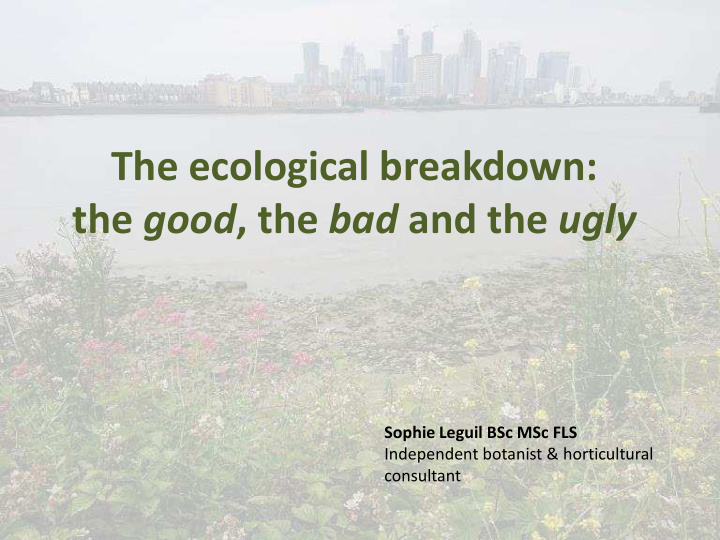



The ecological breakdown: the good , the bad and the ugly Sophie Leguil BSc MSc FLS Independent botanist & horticultural consultant
Doom and gloom
11,700 years of stability
And now... Quantifying the state of nine natural systems
Biosphere integrity The “6 th Mass Extinction” • Up to 58,000 species lost each year • Vertebrate populations have declined by 60 per cent between 1970 – 2014 • 40% of insect species are declining A dramatic reduction in genetic diversity available to withstand change
Biosphere integrity Environmental change is increasing in scale and in speed
Land use Source: UN Sustainable Development Report 2019; World Atlas of Desertification Topsoil is being lost 10 to 40 times faster than it is being replenished by natural processes
Chemical flows • Phosphorus & nitrogen run-off from fertiliser use ends up in the sea, reducing the availability of oxygen • On land, nitrogen deposition can decrease the diversity of plants, lichens and mosses (GO2NE working group) Nitrogen deposition in Europe “Dead zones” have quadrupled since 1950, now covering an area the size of the UK
The situation of the UK “ One of the most nature- depleted countries in the world ”, ranked 189 out of 218 countries for biodiversity intactness
The situation of the UK • One in seven species threatened with extinction • 41% of species studied have experienced decline since 1970 • 17 per cent of arable land shows signs of erosion (Environment Agency 2004; SSLRC 2000) State of Nature, 2019
Consequences of the ecological breakdown The impacts will be felt at local and global level: • extreme weather disrupting infrastructure & impacting health • loss of insect biodiversity & soil degradation threatening food supply • displaced populations causing political unrest ...
Impacts are already felt on biodiversity in the UK • Shift in geographical and time range • New migratory species arriving from the continent • Drought is affecting the growth rate of trees Proportion of species flowering early, late or as expected around New Year, BSBI New Year Plant Hunt 2014-2020
Are we doomed?
Hope Can environmental change be reversed at all? The hole in the ozone layer , which filters UV radiations was dramatically reduced in size thanks to the Montreal Protocol (1987) which banned the production of chlorofluorocarbons On a smaller scale, rewilding has proved effective in creating habitat for threatened species, increasing population size and chances of survival – see for example the purple emperor butterfly at Knepp Castle, Sussex
Can the horticultural industry help cope with environmental change? ...or is it part of the problem? - peat use is still widespread - it often relies on imported plants, which could carry pests or diseases - introduced plants may become invasive - the transport of plants by land/air bears significant carbon costs - plants are not always selected with biodiversity in mind - growing often requires single-use plastics, large quantities of electricity, water, pesticides and fertilisers - poor plant selection, “fast plant fashion” can lead to waste
Horticulture could in fact contribute to reversal at several levels • Biosphere integrity • Biochemical flows • Land-system change • Freshwater use
Promoting a healthy use of land
Working with nature
Adopting sustainable practices
Sourcing plants with care
Learning from science And rethinking some practices... Hicks et al. 2016
Thank you
Recommend
More recommend